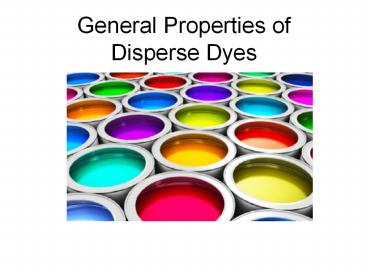General Properties of Disperse Dyes - PowerPoint PPT Presentation
Title:
General Properties of Disperse Dyes
Description:
This article mainly introduces some general properties of disperse dyes. Visit for more information. – PowerPoint PPT presentation
Number of Views:176
Title: General Properties of Disperse Dyes
1
General Properties of Disperse Dyes
2
Introduction
- Disperse dyes are a class of nonionic dyes that
are present in a highly dispersed state in water.
Disperse dyes are the only water-insoluble dyes
for the dyeing of polyesters and acetates. And
they are also used as colorants in the
manufacture of "ironing" transfer crayons and
inks. The article introduces some general
properties of disperse dyes.
3
Appearance
- The appearance of disperse dyes can be divided in
to three types power dye, granular dye and
liquid dye. Generally, the powdery disperse dyes,
such as disperse yellow 163 and disperse red 277,
contain a dustproofing agent, so the powder is
fine but does not fly like dust. Granular
disperse dyes are produced by commercial
processing using new granulation and drying
technology. When the granular dye is weighed,
there is no flying dust, but the volume of the
product is larger. The liquid dye used for
padding or printing does not settle evenly, the
dispersant content is small and the color is deep.
4
Color shade
- The shade of the dye refers to the color and
brightness of the dyed textile fiber.
Commercially, shade is an important indicator of
dye properties and evaluation of dye quality. For
the applications of dyes, control of the shade of
dyes is an important guarantee for the quality of
dyed products. The color shade of a qualified
commercial dye must be consistent with the
standard under the same dyeing conditions. The
color shade of the disperse dye is determined by
its structure, but it is also related to the
synthetic route of the dye. Dyes of the same
structure often have different shades due to
their different manufacturing processes. The
shades of the same dye dyed on polyester and the
shades dyed on vinegar, nylon, acrylic or other
synthetic fibers are the same or different.
Therefore, the same fiber material must be used
when selecting dyes and comparing dye shades. The
brightness of disperse dyes varies from species
to species. Dyes with higher brightness usually
add "Billi" or "Light" to the name of the dye
product to show the difference. Fluorescent
disperse dyes are limited to yellow, orange, and
red.
5
Solubility
- The solubility of disperse dyes in water is very
low, about 0.1 32 mg / liter in cold water and
about 0.2 100 mg / liter in hot water at 80?.
Heated the water till the temperature rises to
130? in a pressure vessel, solubility can up to
200 mg / liter. The solubility of the dye is
strongly influenced by the temperature and
related to the structure and molecular weight of
the dye. Commercial disperse dyes usually contain
more anionic dispersing agents, which have a
significant solubilizing effect on disperse dyes.
When preparing dyeing solutions, most of the dyes
that can be dissolved in water are various
dispersants, and the fine dye particles are
surrounded by the water-soluble dispersant. The
dye solution of the disperse dye is not actually
a solution. This incompletely dissolved liquid is
called a dispersion.
6
PH Sensitivity
- Disperse dyes have many varieties and wide
chromatograms, and the sensitivity to sulfuric
acid is very inconsistent. Dyeing liquids with
different pH values often lead to different
dyeing results, affecting the color depth, and
even causing color change. In a weakly acidic
medium (pH 4.5 to 5.5), the disperse dye is in
the most stable state. The pH of the disperse dye
solution varies, some are neutral and some are
slightly alkaline. Before the dyeing, it should
be adjust to the specified pH with acetic acid.
During the dyeing process, the pH of the dyeing
solution is sometimes gradually increased, and if
necessary, formic acid and ammonium sulfate may
be added to keep the dyeing solution in a weakly
acidic state. Some disperse dyes with the azo
structure are very sensitive to alkali and are
not resistant to reduction. Disperse dyes with
ester groups, cyano groups or amide groups are
mostly affected by alkali hydrolysis to affect
their normal shade.































